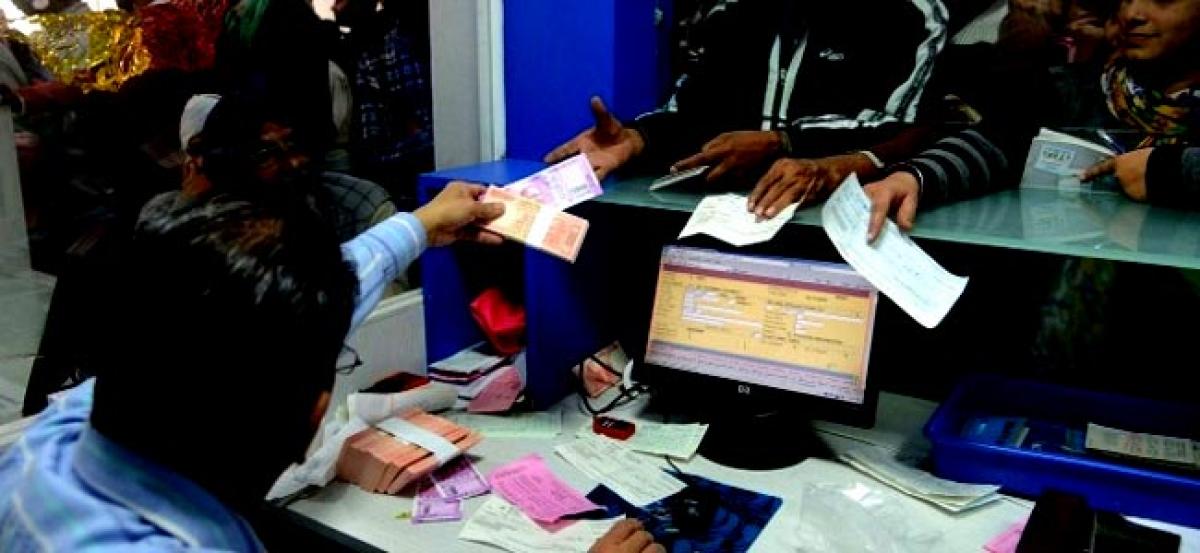Live
- Centre to offload 25 lakh tonnes of wheat in open market to bring down price
- New Zealand Test captain Tom Latham joins Warwickshire for 2025 season
- Delhi HC reserves verdict on anticipatory bail plea of Puja Khedkar
- Telangana CM Revanth Reddy Participates in Statewide Socio-Economic Survey
- Sanjay Raut hails Priyanka Gandhi as 'sherni'; SS-UBT leader whacks Congress
- From Window Shopping to Instant Deliveries: How Gen Z is Changing Retail
- Piyush Goyal launches CII's 'Ease of Doing Business' portal
- Why Apostille in Delhi and UAE Embassy Attestation in Delhi Are Crucial for International Travel and Work
- How to Promote Creativity in Children and What Preschools Should Do
- Telangana Revises Class 10 Exam Pattern: Internal Marks Removed
Just In

The struggle on bad loans that soared to menacing proportion in 2016 would continue in the new year as many more industrial units, especially in the MSME sector, may turn defaulters due to the cash shortage following demonetisation.
New Delhi: The struggle on bad loans that soared to menacing proportion in 2016 would continue in the new year as many more industrial units, especially in the MSME sector, may turn defaulters due to the cash shortage following demonetisation.
The withdrawal of high-value cash will also hit the bottom line of banks that have been busy exchanging old notes and issuing valid currency at the cost of credit growth and loan recovery.
The banking sector came almost to a standstill for nearly two months after the surprise announcement by Prime Minister Narendra Modi on November 8 scrapping Rs 500 and 1,000 notes.
Out of the 27 public sector banks, 14 posted losses, aggregating Rs 34,142 crore, last fiscal and the trend has not shown any improvement in the first half of 2016-17.
Worryingly, even private lenders have witnessed a jump in bad loans, pushing down their net profit.
Public banks have seen nearly Rs 80,000 crore increase in gross non-performing assets (NPAs) in the three months ended September 2016.
Their gross NPAs rose to Rs 6,30,323 crore as against Rs 5,50,346 crore by June-end.
Mindful of an NPA surge in the aftermath of the cash recall, RBI has provided additional 60 days for repayment of housing, car, farm and other loans worth up to Rs 1 crore.
However, bankers feel that NPAs will move up at the end of the fourth quarter when the impact of the notes ban takes hold.
As far as wilful defaulters are concerned, PSBs have reported 16% rise at 8,167 that collectively owe them Rs 76,685 crore at the end of March 2016. Dues to the banks went up by 28.5% to Rs 76,685 crore in 2015-16, from the earlier Rs 59,656 crore.
On the recapitalisation front, the government has already announced funds infusion of Rs 22,915 crore, out of the Rs 25,000 crore earmarked for 13 PSBs for the current fiscal. Of this, 75% has already been released to them.
Banks have not been able to carry out their lending activity optimally since November 8 as their prime focus turned to exchanging notes and accepting old currency.
The result: Bank credit shrank by a whopping Rs 61,000 crore, or 0.8%, during the fortnight to November 25.
The outstanding credit stood at Rs 72.92 lakh crore as of November 25, according to Reserve Bank of India data. The year-on-year credit growth was just 6.6 per cent, down from 9.3 per cent.
Bankers say there has been a sharp plunge in credit demand as the economy started to feel the adverse impact of the decision to cancel legal tender status of old currency notes.
The loss of business and rise in bad loans during the year has bumped up capital requirement for banks. Bankers, in their pre-budget meeting, have already requested the government for higher capital infusion to meet global risk norms.
Bankers also fear that the restrictions on withdrawal of cash from banks and ATMs are likely to continue beyond December 30 as currency printing presses and RBI have not been able to keep pace with the demand for new notes.
Banks at many places are not in a position to disburse even the current limit of Rs 24,000 per week due to the cash crunch and are rationing it out depending on cash availability.
In case this limit is withdrawn from January 2, it is unlikely that banks would be able to meet a surge in demand.
RBI could infuse Rs 5.92 lakh crore in the banking system between November 9 and December 19 against Rs 15.4 lakh crore of scrapped notes.
During the year, the banking space witnessed entry of some new players like Airtel payments bank, Equitas and Ujjivan small finance banks. As part of its financial inclusion agenda, RBI gave in-principle approval to 21 entities to set up payments banks and small banks.
More entities would go on stream in the coming year so that more people can come under the ambit of the formal banking structure.
On the flip side, banking sector was rocked by the biggest ever data breach affecting 32.4 lakh debit cards of several public and private bank customers.
Details of certain cards had been possibly compromised at ATMs linked to the ATM Switch of one of the service providers.
Following the data breach, 19 banks had recalled the compromised cards.
Besides, some of the employees of banks such as Axis Bank, HDFC Bank and Bank of Baroda were found involved in malpractices as part of the demonetisation drive.

© 2024 Hyderabad Media House Limited/The Hans India. All rights reserved. Powered by hocalwire.com







